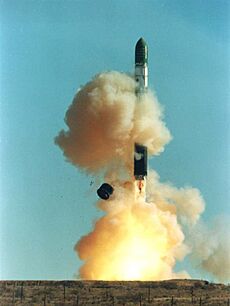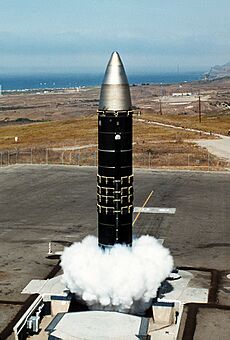START I facts for kids
| Strategic Arms Reduction Treaty Договор о сокращении стратегических наступательных вооружений |
|
|---|---|
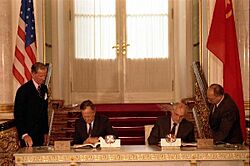
Presidents George H. W. Bush and Mikhail Gorbachev sign START, 31 July 1991
|
|
| Type | Strategic nuclear disarmament |
| Drafted | 29 June 1982 – June 1991 |
| Signed | 31 July 1991 |
| Location | Moscow, Soviet Union |
| Effective | 5 December 1994 |
| Condition | Ratification of both parties |
| Expiration | 5 December 2009 |
| Signatories | |
| Parties | |
| Languages | Russian, English |
START I stands for the Strategic Arms Reduction Treaty. It was a very important agreement between the United States and the Soviet Union (which is now mostly Russia). This treaty aimed to reduce and limit the number of powerful nuclear weapons each country had.
The START I treaty was signed on July 31, 1991. It officially started on December 5, 1994. This agreement stopped both countries from having more than 6,000 nuclear warheads. It also limited them to a total of 1,600 intercontinental ballistic missiles (ICBMs) and bombers.
This treaty was one of the biggest and most complicated agreements ever made to control weapons. By 2001, it had helped remove about 80% of all strategic nuclear weapons that existed at the time. US President Ronald Reagan first suggested the idea for this treaty. It was later called START I when talks began for a new treaty, START II.
The START I treaty ended on December 5, 2009. However, a new treaty called New START was signed on April 8, 2010. This new agreement was signed in Prague by US President Barack Obama and Russian President Dmitry Medvedev. After both countries approved it, the New START treaty began on February 5, 2011. It continues to reduce the number of strategic nuclear weapons until February 2026.
Contents
Why Was START I Proposed?
The idea for the START treaty was first shared by US President Ronald Reagan. He announced it on May 9, 1982, at his old college, Eureka College. Reagan then presented the plan in Geneva on June 29, 1982. He suggested a big reduction in strategic forces, which he called SALT III.
The first part of his plan was to reduce the total number of warheads on any missile type to 5,000. There would be an extra limit of 2,500 warheads specifically on ICBMs. Also, only 850 ICBMs would be allowed in total. This included a limit of 110 "heavy throw" missiles, like the Soviet SS-18. There were also limits on the total "throw weight" of the missiles. Throw weight means how much payload a missile can carry.
The second part of the plan added similar limits on heavy bombers and their warheads. It also covered other strategic weapon systems.
At that time, the US had many more strategic bombers. The older B-52 planes were a strong threat. They started using AGM-86 cruise missiles in 1982 because the Soviet Union had improved its air defenses. The US was also starting to use the new B-1B Lancer bomber. Secretly, they were also developing the Advanced Technology Bomber, which later became the B-2 Spirit stealth bomber.
The Soviet Union's bomber force was less of a threat to the US. Their bombers were mostly used to attack US ships in the Atlantic Ocean and targets in Europe and Asia. Even though the Soviets had 1,200 medium and heavy bombers, only about 150 of them could reach North America. These were the Tupolev Tu-95s and Myasishchev M-4s. They also had trouble getting past US air defenses.
Things changed in 1984 when new Tu-95MS and Tu-160 bombers appeared. These new planes carried the first Soviet AS-15 cruise missiles. By limiting how quickly these new weapons could be added, the US hoped to keep a strategic advantage for a while.
Some people thought Reagan's plan was unfair to the Soviet Union. They felt it would make the US have to change its forces much less than the Soviets. However, the Soviets had a huge advantage in "throw weight" with their large ICBMs. This meant they could deliver much more destructive power.
What Were the Costs of START I?
Several groups studied how much it would cost the US government to put START I into action. These groups included the Congressional Budget Office (CBO) and the US Senate Foreign Relations Committee (SFRC).
The CBO thought the total cost would be between $410 million and $1.83 billion for one-time expenses. They also estimated ongoing yearly costs of $100 million to $390 million.
The SFRC estimated one-time costs of $200 million to $1 billion. They believed the total cost for inspections over the 15 years of the treaty would be $1.25 billion to $2.05 billion.
Besides the costs of putting the treaty into action, the US also helped the countries that used to be part of the Soviet Union. This help came through the Cooperative Threat Reduction Program. This program added $591 million to the cost for the US.
After the treaty was put into action, the number of nuclear weapons in the former Soviet Union dropped from 12,000 to 3,500. The US also saved money because it didn't need to spend as much on keeping up and improving its nuclear weapons. The CBO estimated these savings would be about $46 billion in the first five years. By 2010, the savings could reach around $130 billion. This meant the treaty would pay for itself many times over.
There was also a concern that Russia might not follow the rules of the treaty. The US Senate Defence Committee worried that Russia could secretly make missiles or give wrong numbers about its warheads. However, military experts decided that the risk of a major violation was small enough to accept. Another concern was that Russia might spy during inspections of US military bases. This risk was also considered acceptable.
Considering the possible savings and the low risks, President Reagan and the US government decided that START I was a good plan for reducing nuclear weapons.
How Were Negotiations Handled?
Talks for START I began in May 1982. However, negotiations were delayed several times. This was because the Soviet leaders before Gorbachev thought the US agreement terms were not fair. When Reagan introduced the Strategic Defense Initiative (SDI) program in 1983, the Soviets saw it as a threat. They stopped setting a time for more talks.
But in January 1985, US Secretary of State George Shultz and Soviet Foreign Minister Andrei Gromyko discussed a new plan. This plan had three parts: intermediate-range forces, strategic defense, and missile defense. During the Reykjavík Summit between Reagan and Gorbachev in October 1986, talks for START sped up. They focused on reducing strategic weapons after the Intermediate-Range Nuclear Forces Treaty was signed in December 1987.
However, a big nuclear arms race continued in the 1980s. It finally ended in 1991. At that point, both sides had about 10,000 strategic warheads, keeping a balance of power.
How Was the Treaty Verified?
Arms control treaties use many ways to make sure countries follow the rules. The START Treaty had the most detailed and strict ways to check compliance at the time. It included twelve different types of inspections.
Countries had to exchange information and declare exact numbers. This included technical details, locations, movements, and the status of all offensive nuclear threats. The national technical means of verification (NTM) rule protected satellites and other ways countries gathered information. These systems helped make sure everyone followed the international treaties.
New on-site inspections (OSI) and Perimeter and Portal Continuous Monitoring (PPCM) helped keep the treaty strong. These systems allowed a representative from the inspecting country to be present at all times. Also, countries had to share information from ballistic missile flight tests. This included exchanging tapes and not hiding data through encryption.
When Was START I Signed?
The negotiations that led to the treaty signing started in May 1982. In November 1983, the Soviet Union stopped talking with the US. This happened after the US placed intermediate-range missiles in Europe.
In January 1985, US Secretary of State George Shultz and Soviet Foreign Minister Andrey Gromyko worked out a three-part plan. This plan covered strategic weapons, intermediate missiles, and missile defense. It got a lot of attention at the Reykjavik Summit between Ronald Reagan and Mikhail Gorbachev. This eventually led to the signing of the Intermediate-Range Nuclear Forces Treaty in December 1987.
Talks about a full strategic arms reduction continued. The START Treaty was officially signed by US President George H. W. Bush and Soviet General Secretary Gorbachev on July 31, 1991.
How Was START I Put into Action?
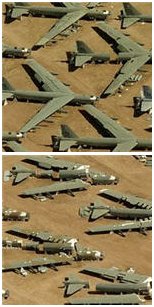
As part of the treaty, 375 B-52 bombers were flown to a special center in Arizona. There, all usable parts were removed. Then, a huge 13,000-pound steel blade, dropped from a crane, cut each bomber into five pieces. This "guillotine" sliced each plane four times, cutting off the wings and leaving the main body in three parts.
The cut-up B-52s stayed in place for three months. This allowed Russian satellites to confirm that the bombers had been destroyed. After that, the metal was sold for scrap.
After the Soviet Union broke apart, its treaty duties went to twelve new countries. Turkmenistan and Uzbekistan each got rid of their one nuclear-related site. Inspections stopped there. Inspections continued in Belarus, Kazakhstan, Russia, and Ukraine. Belarus, Kazakhstan, and Ukraine became non-nuclear weapon states. This means they agreed not to have nuclear weapons under the Treaty on the Non-Proliferation of Nuclear Weapons.
Was START I Effective?
Belarus, Kazakhstan, and Ukraine have either gotten rid of all their nuclear weapons or sent them to Russia. The US and Russia have both reduced their delivery vehicles (like missiles and bombers) to 1,600 each. They also have no more than 6,000 warheads.
A report from the US State Department in 2010 said that Russia was not fully following the treaty when it ended in December 2009. The report did not say exactly what Russia's problems were.
One time, Russia was accused of breaking the START I Treaty in 1994. The US said Russia had changed its SS-19 ICBM into a space-launch vehicle without telling anyone. Russia said it didn't have to report missiles that were changed into space vehicles. Russia also reportedly used SS-25 missiles for space launches. The US was concerned because it didn't have accurate numbers and locations of Russian ICBMs due to these actions. This disagreement was solved in 1995.
Expiration and Renewal of START I
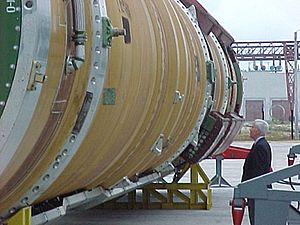
START I ended on December 5, 2009. However, both the US and Russia agreed to keep following the treaty's rules until a new agreement was made. There were ideas to renew and even expand the treaty. US President Barack Obama supported these ideas.
Some Russian officials said that a new treaty could be signed if the US stopped its plans to put missile defense parts in Central Europe. They were talking about placing ten interceptor missiles in Poland and radar in the Czech Republic. Russia felt this was an attempt to "surround Russia with a missile defense ring."
On March 17, 2009, Russian President Medvedev said Russia would start a "large-scale" rearmament of its nuclear weapons. He accused NATO of expanding closer to Russian borders. He ordered the rearmament to begin in 2011, increasing army, naval, and nuclear power. Also, the head of Russia's strategic missile forces said Russia would start using its next-generation RS-24 missiles after START I expired.
Despite these tensions, the US and Russia started talking again on May 4, 2009. They began renegotiating START and counting nuclear warheads and their delivery vehicles for a new agreement. Both sides agreed to make more cuts, aiming for about 1,000 to 1,500 warheads each. The US was open to Russia's idea of using radar in Azerbaijan instead of Eastern Europe for the missile system. The George W. Bush administration had said the Eastern Europe defense system was to stop Iran, but Russia worried it could be used against them. This willingness to compromise led to a new phase of arms reduction.
On July 6, 2009, Obama and Medvedev signed a "Joint understanding for a follow-on agreement to START-1" in Moscow. They agreed to reduce the number of deployed warheads to 1,500–1,675 on 500–1,100 delivery systems. A new treaty was to be signed before START-1 ended in December 2009. The reductions would happen within seven years. After many months of talks, Obama and Medvedev signed the new treaty, Measures to Further Reduction and Limitation of Strategic Offensive Arms, in Prague, Czech Republic, on April 8, 2010.
New START Treaty
The New START Treaty put even more limits on the United States and Russia. It required them to significantly reduce their strategic weapons within seven years of it starting. The new treaty has three main parts: the treaty itself, a protocol with more rules, and technical details.
The limits were carefully planned by defense experts. These new limits include 1,550 nuclear warheads. This counts warheads on deployed ICBMs, warheads on deployed SLBMs (submarine-launched ballistic missiles), and even any deployed heavy bomber ready for nuclear weapons. This is 74% fewer than the limit in the 1991 treaty and 30% fewer than the limit in the 2002 Treaty of Moscow.
Both countries are also limited to 800 deployed and non-deployed ICBM launchers, SLBM launchers, and heavy bombers with nuclear weapons. There's also a separate limit of 700 deployed ICBMs, deployed SLBMs, and deployed heavy bombers ready for nuclear weapons. This is less than half the limit for delivery vehicles in the old treaty. Even with these new rules, the treaty does not limit the testing, development, or use of current or planned US missile defense programs. It also doesn't limit low-range conventional strike weapons.
The new treaty lasts for ten years. It can be extended for up to five years at a time. It also has a standard rule that allows a country to leave the agreement, like most other arms control treaties. Newer treaties have replaced this one.
Images for kids
-
Jimmy Carter and Leonid Brezhnev sign the SALT II treaty, June 18, 1979, in Vienna.
See also
- Strategic Arms Limitation Talks
- START II
- START III
- RS-24
- New START


